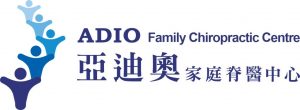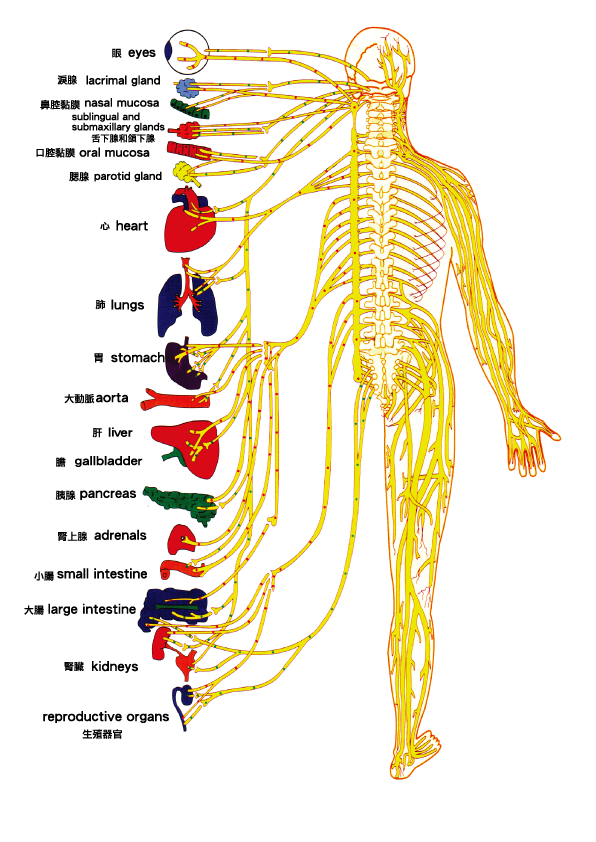
The power that made the body and heals the body 脊科醫學 啟動原創力
About Chiropractic
Understand Our Nervous System
Vertebral subluxation is the impairment of optimal expression of your nervous system caused by physical, chemical, or emotional stress. The nervous system controls and coordinates the body’s organs and the activities of each cell. If the nervous system is not disturbed by the spinal subluxation, you can achieve an ideal health state and fully embody the body’s innate self-healing power. Chiropractic can help to prevent vertebral subluxation, effectively enhance the nervous system’s performance, and ultimately achieve the best state of health and show its health potential.

- Blurred vision
- Bone spur
- Temporomandibular disorder (TMJ)
- Allergic rhinitis
- Asthma
Digestive issues
- Sciatica
- Urinary issues
- Disc Herniation
- Low back pain
- Scoliosis
- Sciatica
Degenerative joint disease
Plantar Fasciitis
- Frozen shoulder
- Tennis elbow
- Golf elbow
- Trigger finger
- Carpal tunnel syndrome
There are two main types of headaches, primary headaches and secondary headaches. 95% of headaches are primary headaches, including migraine headaches, tension headaches and cervicogenic headaches. Cervicogenic headache is caused by structural problems of the cervical vertebrae or injury to the neck, especially at C2-C3. Chiropractors will adjust the corresponding subluxated cervical vertebral joints to reduce the pressure on the nerves, which allows cervical nerves to optimize and foster our body’s self-healing power.
There are many causes of neck pain. Neck pain can be caused by subluxation due to stress and strain of daily activities. Most neck problems happen after years of wear and tear on the parts of the cervical spine. The muscles that have been pulled or injured may cause neck pain due to repetitive motion of neck muscles. Other than that, the problem may be coming from irritation or injury in other spine tissues, such as the disc or ligaments. When this happens, the neck muscles may go into spasm, and patients might feel pain and soreness in these areas.
Back pain is the leading cause of disability worldwide. There are many causes of low back pain, the most common of which are subluxation of the lumbar spine caused by sports injuries and occupational injuries. Degenerative diseases of the back can also cause back pain.
Acute Back Pain or Chronic Back Pain
Symptoms range from a dull ache to a stabbing or shooting sensation. The pain may make it hard to move or stand up straight. Acute back pain comes on suddenly, often after an injury from sports or heavy lifting.
Sciatica most commonly occurs when a herniated disk or a bone spur on the spine compresses part of the nerve. Our Sciatic nerve is the largest nerve in our body, which arises from nerves coming from L4 to S3. When our joints are subluxated, it causes inflammation, pain and often some numbness in the affected leg. Some may have mixed up sciatica vs piriformis syndrome, the cause of piriformis syndrome is tight piriformis muscle, causing numbness or weakness down the legs, the following video will show how to stretch our piriformis muscle.
Disc herniation is a medical condition affecting the spine in which a tear in the disc. A disc begins to herniate when its jelly-like nucleus has been pushed out due to wear and tear or a sudden injury. This pressure against the spine may interrupt the nervous system and trigger discomfort in different areas depending on which nerves are interrupted. If the disc is herniated at your neck, your shoulder and arm will feel numbness. Sometimes even when you cough, sneeze you will feel this numbness or tingling. If the disc is herniated at your back, your legs may feel numbness and weakness of muscle power. Chiropractic treatment can help move the disc away from the nerve, reducing inflammation of the nerve root and eventually any associated pain and inflammation into the leg.
Scoliosis means that the vertebrae are bent to the side. There are structural scoliosis and functional scoliosis. There are genetic risks caused by scoliosis but most of them are idiopathic. The cause of structural scoliosis could be caused by the rotation of the vertebral body leading to the twisting of the vertebral column. While functional scoliosis is caused by incorrect posture, unequal leg length and muscle tension etc.
Bone spurs are bone hyperplasia which is a kind of normal physiological degeneration. Bone spurs formed in the spine can suppress spinal nerves, blood vessels and soft tissues, causing symptoms such as paralysis and muscle atrophy. Bone spurs are mostly caused by long-term excessive joint pressure, such as poor posture or excessive strain, new bone and cartilage tissue will grow out of the joint near the end of the bone to fill the void due to loss. These new bone and cartilage tissues appear as needles on X-rays, so they are called bone spurs.
The carpal tunnel is a channel composed of the carpal bone and the transverse carpal ligament. The tube contains multiple hand tendons and median nerve lines. Due to the narrow space in the carpal tunnel, repetitive wrist movements such as turning the wrist can easily cause inflammation and swelling of the tendons in the carpal tunnel, causing the carpal tunnel to become gradually narrowed and compressed. The median nerve, so the thumb, index finger, middle finger and half of the ring finger will feel tingling, burning and numbness. Long-term use of computer mice, touch-sensitive mobile phones and smart electronic products is a high-risk group of carpal tunnel syndrome (also known as computer hands).